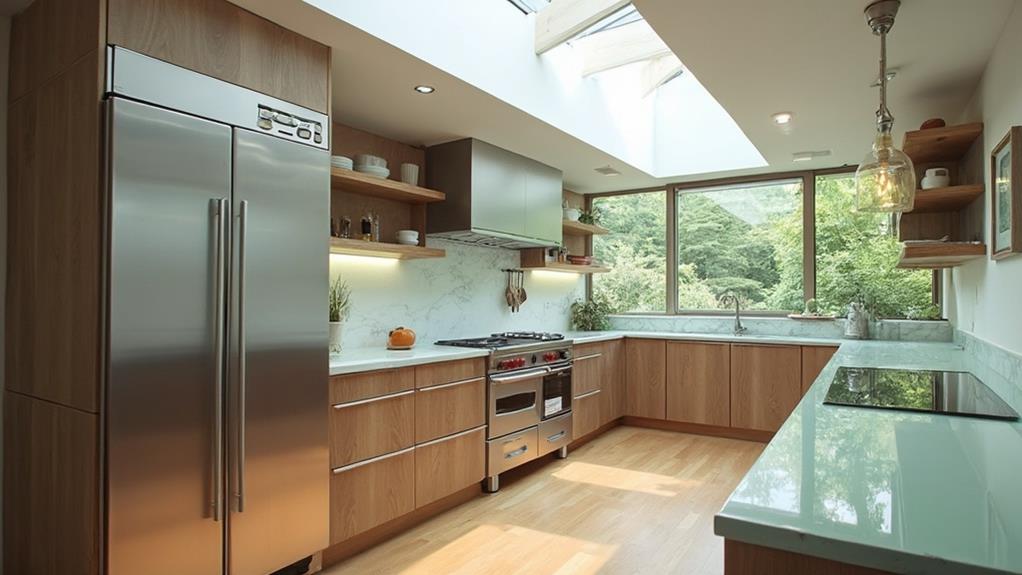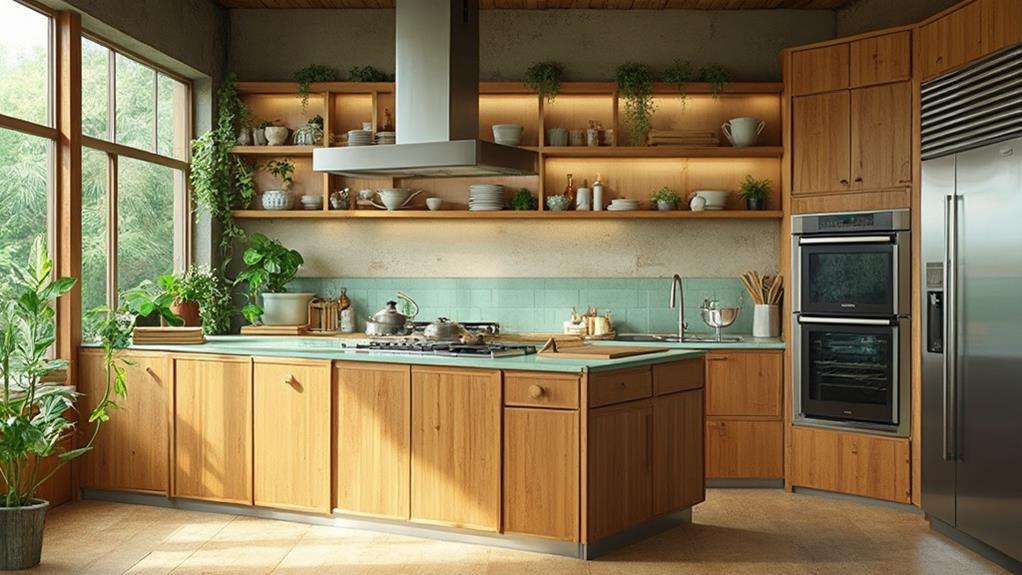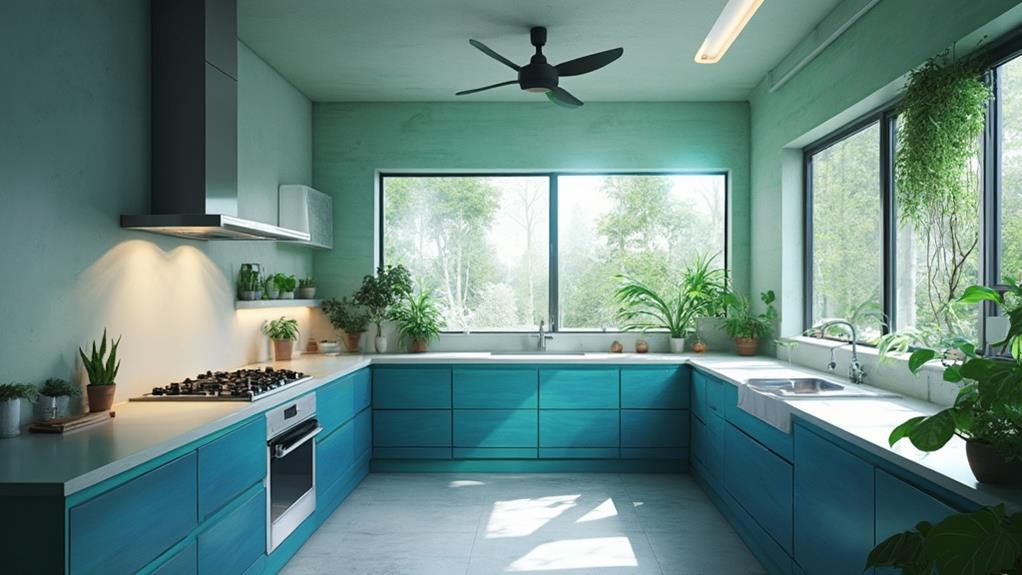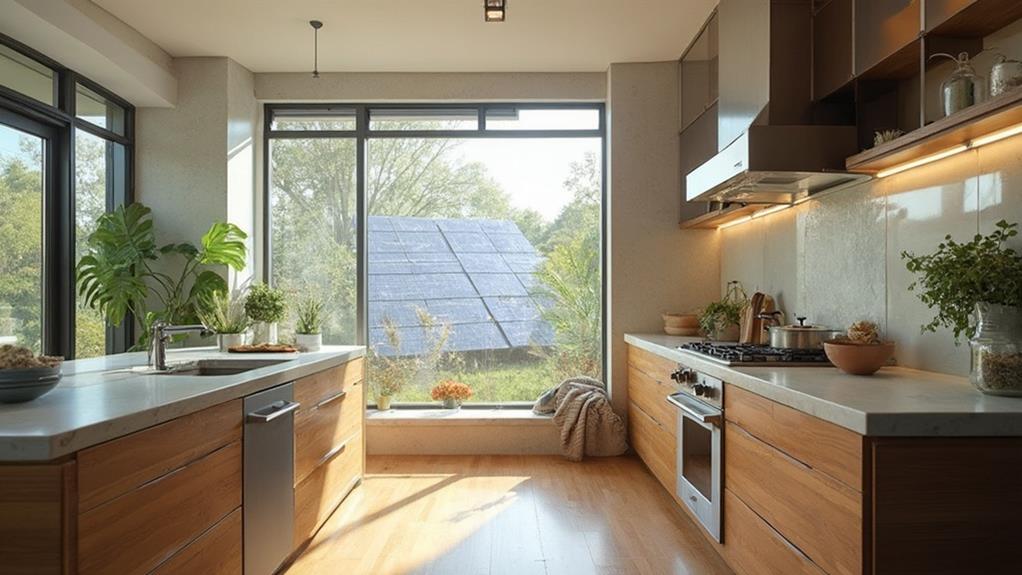To boost your home's energy efficiency with a kitchen redesign, start by selecting ENERGY STAR certified appliances that use 10-50% less energy. Prioritize natural light and LED bulbs for optimal illumination. Choose sustainable materials like bamboo or recycled countertops, and opt for low-VOC paints. Implement smart storage solutions with pull-out shelves and vertical dividers to maximize space. Ensure proper ventilation with an efficient range hood and strategically placed windows for cross-ventilation. Don't forget water conservation techniques, such as low-flow faucets and ENERGY STAR dishwashers. By incorporating these elements, you'll create a kitchen that's both eco-friendly and functional. Discover more ways to enhance your kitchen's energy efficiency below.
Energy-Efficient Appliance Selection

When selecting appliances for your energy-efficient kitchen, prioritize those with ENERGY STAR certification. These appliances use 10-50% less energy than standard models, significantly reducing your home's energy consumption and utility bills.
Look for refrigerators with top-mounted freezers, as they're typically more efficient than side-by-side or bottom-freezer models. Choose an induction cooktop or energy-efficient electric range instead of gas stoves, as they offer better heat transfer and lower energy loss.
Opt for a dishwasher with multiple wash cycle options and sensors that adjust water usage based on load size. Consider a convection oven, which circulates hot air more efficiently, reducing cooking times and energy use. For smaller appliances, select energy-efficient models of microwaves, toasters, and coffee makers. Don't forget about lighting; install LED bulbs in all fixtures and under-cabinet lighting to minimize electricity consumption.
When shopping, compare the annual energy use listed on the EnergyGuide labels to make informed decisions. Remember that investing in energy-efficient appliances may cost more upfront but will save you money in the long run through reduced energy bills and potential rebates or tax incentives.
Optimal Lighting Strategies
To maximize energy efficiency in your kitchen, implementing optimal lighting strategies is crucial. Start by prioritizing natural light, positioning windows and skylights to illuminate work areas during peak hours. When artificial lighting is necessary, opt for LED bulbs, which consume less energy and last longer than traditional incandescent or fluorescent options.
Install dimmer switches to adjust light levels according to your needs, reducing energy waste when full brightness isn't required. Utilize task lighting under cabinets or above workstations to focus illumination where it's needed most, allowing you to keep overall ambient lighting at a lower level. Consider motion sensors for pantries or less-frequented areas to ensure lights aren't left on unnecessarily.
Incorporate reflective surfaces, such as light-colored countertops or backsplashes, to amplify existing light and reduce the need for additional fixtures. Don't overlook the importance of regular maintenance – clean light fixtures and bulbs to maintain their efficiency. Lastly, strategically place lighting to complement your kitchen's layout, ensuring that every corner is well-lit without overcompensating. By combining these strategies, you'll create a well-lit, energy-efficient kitchen that enhances both functionality and aesthetics.
Sustainable Materials and Finishes

Beyond lighting, the materials and finishes you choose for your kitchen play a significant role in its overall energy efficiency. When selecting countertops, opt for recycled or sustainable materials like bamboo, reclaimed wood, or recycled glass. These options not only reduce environmental impact but also often require less energy to produce and transport.
For flooring, consider cork or linoleum, which are renewable and biodegradable. They're also excellent insulators, helping to maintain a comfortable temperature in your kitchen. When it comes to cabinetry, look for FSC-certified wood or bamboo, ensuring sustainable sourcing.
Choose low-VOC or zero-VOC paints and finishes to improve indoor air quality and reduce harmful emissions. For backsplashes, recycled glass or ceramic tiles are eco-friendly options that can add both style and sustainability to your kitchen.
Don't forget about your appliances' finishes. Stainless steel is recyclable and durable, making it a sustainable choice. Alternatively, consider appliances with powder-coated finishes, which are more environmentally friendly than traditional paint.
Smart Storage Solutions
Smart storage solutions are essential for an energy-efficient kitchen. They help you maximize space, reduce clutter, and minimize the need for additional appliances or lighting. Start by installing pull-out shelves in lower cabinets to make items easily accessible without wasting energy searching. Utilize lazy Susans in corner cabinets to eliminate hard-to-reach spaces.
Opt for deep drawers instead of shelves for pots, pans, and dishes. They're more efficient and reduce the need to bend or stretch. Install vertical dividers for baking sheets and cutting boards to keep them organized and easily retrievable. Use door-mounted racks for spices and small items, freeing up valuable counter space.
Consider a pantry with adjustable shelving to accommodate various food items and small appliances. This centralized storage reduces the need to open the refrigerator frequently. Implement a recycling center with separate bins for different materials, promoting sustainable practices.
Lastly, invest in airtight food storage containers to keep ingredients fresh longer, reducing food waste and refrigerator energy consumption. By implementing these smart storage solutions, you'll create a more organized, efficient, and energy-conscious kitchen space.
Ventilation and Air Flow

Proper ventilation and air flow are crucial elements in designing an energy-efficient kitchen. They help regulate temperature, remove excess moisture, and eliminate cooking odors and pollutants. To optimize ventilation, install a high-quality range hood that's appropriately sized for your cooktop. Ensure it vents to the outside rather than recirculating air within the kitchen.
Consider adding a ceiling fan to improve air circulation and reduce the need for air conditioning. Position your windows strategically to create cross-ventilation, allowing fresh air to flow through the kitchen naturally. Install energy-efficient windows that can be easily opened and closed to control air flow as needed.
Don't forget about your HVAC system. Place air vents away from the cooking area to prevent hot air from interfering with your cooling efforts. Use a programmable thermostat to regulate temperature based on your kitchen usage patterns. Additionally, seal any gaps or cracks around windows, doors, and pipe penetrations to prevent air leaks. This will help maintain a consistent temperature and reduce the workload on your heating and cooling systems, ultimately improving your kitchen's overall energy efficiency.
Water Conservation Techniques
Conservation of water is a critical aspect of an energy-efficient kitchen design. To reduce water consumption, start by installing low-flow faucets and aerators. These devices can cut water usage by up to 60% without compromising functionality.
Opt for a dual-flush toilet if your kitchen includes a bathroom, allowing you to choose between a full or partial flush.
When selecting appliances, look for water-efficient models. Choose a dishwasher with the ENERGY STAR label, which uses less water and energy than standard models. If you're replacing your refrigerator, avoid models with built-in water dispensers, as they can waste water and increase energy consumption.
Consider installing a greywater system to recycle water from your sink for use in toilet flushing or garden irrigation. Capture and store rainwater with a rain barrel connected to your gutters, providing a free source of water for plants or outdoor cleaning.
Lastly, fix any leaks promptly and insulate hot water pipes to reduce heat loss and water waste. By implementing these water conservation techniques, you'll not only save on your water bill but also contribute to a more sustainable and energy-efficient home.
Conclusion
You've now got the tools to create a kitchen that's not just the heart of your home, but also an energy-saving powerhouse. By implementing these strategies, you'll slash your utility bills and reduce your carbon footprint faster than you can say "eco-friendly." Remember, every small change adds up. So go ahead, transform your kitchen into a model of efficiency. Your wallet, the planet, and your future self will thank you a million times over.

